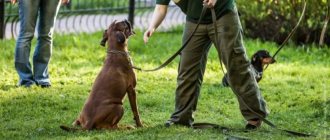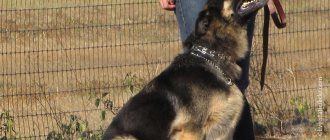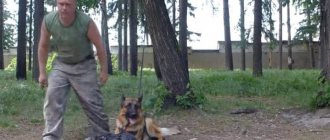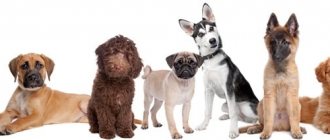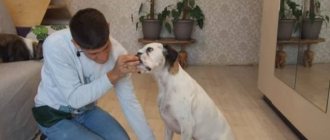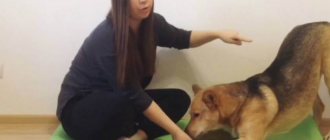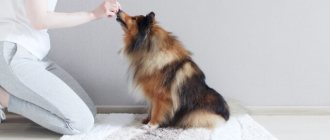Today we will talk about how to teach a dog the “Stay” command. This command is normative and is also often used in everyday life. For example, when you need to put a jumpsuit on a dog or brush it, it is much easier if it stands up straight and does not fall over.
Usually, teaching the “Stand” command begins at the age of 7 months, after the puppy has learned the commands “Sit”, “Lie down” and begins to behave more restrained.
Just like “Sit” and “Lie down,” the “Stand” command is practiced using a contrasting method, that is, it is equally important to use both coercion and encouragement. Coercion is pushing the dog under the stomach, and encouragement is praise and treats.
Some dog trainers advise introducing the dog to the “Stay” command during examination or brushing, but it is better not to do this. Many dogs, especially long-haired ones, do not get any pleasure from these procedures. Due to the unpleasant sensations that follow the “Stay” command, it will be more difficult for you to train your dog. So it’s better to train your puppy to stand separately from the examination.
Stages of training
Dog training is not an easy task and requires a lot of time and patience. In the process, you need to move gradually from simple to complex, from undebugged execution to accurate and trouble-free execution. To begin with, the dog must understand what is required of it (in this case, the command to Stand), and in this it needs help. Every correct action of the dog must be rewarded in order to form a positive reinforcement. This is very important at this stage of training. Wrong or erroneous actions should not be encouraged.
- The first stage is at the very beginning of training, the dog may be distracted by strangers, surrounding noise and other external factors. Therefore, classes should be conducted in a fairly quiet and secluded place.
- The second stage involves similar conditions for training, during which you need to hone the conditioned reflex to the command. To consolidate, they use restraint during execution, and also accompany the actions with an appropriate gesture. Positive reinforcement of correct actions is again used, and delays allow the dog to learn to more willingly and accurately carry out the trainer's gestures and commands.
- The third stage is necessary for further consolidation of acquired conditioned reflexes. Training is already taking place in a new environment for the dog with additional stimuli: strangers, animals, vehicles, noise, etc. To slow down the excitement from surrounding stimuli, the trainer has a different kind of influence on the pet: changes the tone of voice, repeats the command, uses mechanical impact. For final consolidation, numerous training sessions and repetition of what has been learned before are needed. All commands, including “Stop,” must be executed accurately and without failure.
When should you start preparing your dog for shows?
The correct stance, in my opinion, is the most difficult of all the necessary skills for a dog to participate in exhibitions, so training a dog must begin from puppyhood.
Short but regular classes can already be started from the moment the puppy moves from the breeder to the owners.
If experts are always ready to make allowances for inexperience for puppies in the “Baby” age group, then starting from juniors, and even more so in the class of young dogs, a show dog should already demonstrate a well-practised stance.
Socialization of the dog, beautiful productive movements in the ring, as well as show grooming are also very important, but these are separate topics for discussion.
How to teach the “Stand” command with voice and gesture?
- You need to say the command and lift the leash with one hand, and with the other put your hand under the pet’s belly, lifting it.
- It is necessary that the dog does not move.
- After executing the “Stand” command, be sure to pet, praise, and give a treat. This command takes much more time than others. This is due to the fact that the dog needs to concentrate and this position is less comfortable than sitting or lying down.
- Say the command loud and clear.
- Do not say the command more than once.
- After executing a command, do not immediately repeat another command. Firstly, it may be perceived as punishment. Secondly, if you constantly do the same actions and repeat - “Stand”, “Sit”. The dog may develop the idea that he needs to do two commands and he will immediately receive a reward. And in the future it will make 2 commands at once without your participation. And this is not correct.
- It is necessary to alternate teams. You need to be unpredictable for your dog.
- If your dog refuses to comply, walks away, or collapses, be sure to start by tugging on the leash.
- Treats should only be given after a successful command to “Stop”.
- When your dog follows the command well, increase the reward interval, thus bringing the stand to five seconds. When the dog is already standing, start training by moving away from your dog and increasing the time.
- Try to gradually increase the distance between the pet to 2-3 meters and the shutter speed to 10-20 seconds (then you can increase it to a minute).
- You need to release the dog with the command “Walk”.
- After you have taught your adult dog or puppy the “Stay” command, then transfer your training to the street. You need the dog to be focused only on you and not pay attention to extraneous noises.
- It is always necessary to practice the command both on the street and at home.
- Always alternate the command between pleasant actions (praise, treats, walking) and not so pleasant actions (cleaning ears, combing). There is no need for the team to be associated as a punishment. Otherwise, the dog may subsequently refuse to carry out the command or do it reluctantly.
- You can teach a command using a gesture. The usual gesture to stand is to lower your arm with your palm raised and slightly bent at the elbow.
- The dog should not lose sight of you. She always watches her owner with her peripheral vision.
Which motivation (method) to choose?
Applying the same method to absolutely everyone is irrational, since four-legged pets are very different from each other. The most commonly used methods of influence are:
- Treating.
Effective for food dogs. They are motivated by various treats and regular food.
- Toy guidance.
If your pet reacts to the game with much more enthusiasm, then this is a typical gamer. The principle of training here is exactly the same as in the first case, but instead of food, a toy is given as a reward.
- Pushing.
Involves indirect physical impact. The owner places the pet in the desired position by pulling the leash or pulling it by the collar.
- Passive inflection.
It is built on trust between owner and pet. In this case, the initiative rests entirely with the person. He corrects all actions and the final position of the dog by direct influence.
You can use either 1 method or several at once. If none of them brings the desired result, seek help.
Command Stand: basic training rules
The trainer influences the pet in many ways: gestures, clothing, voice, nature of movements, facial expressions. This person also becomes a strong irritant for the dog. It is necessary to establish the correct relationship between the pet and the trainer, so that the dog always carefully observes the movements of the person, trusts him, follows the first command to Stand, is completely obedient and is not at all afraid. Gestures and movements are an important part of the training process. For example, fast and jerky movements can cause a defensive reaction in the animal, after which the dog will become timid or even cowardly at the sight of the trainer. Conducting and organizing training requires taking into account many important points:
- know the dog’s character and behavioral characteristics;
- carefully develop the acquired reflex, without departing from the training program;
- set clear goals before each lesson;
- do not change gestures, signals and words of commands, always give them clearly and equally. You can choose different intonation when the dog behaves inappropriately;
- be sure to encourage correct action;
- try to add variety to the training process, while observing the dog’s interest in the work;
- help the animal with signals and gestures, to understand what is required of it in order to carry out commands as accurately as possible. Encourage in a timely manner;
- draw a clear line between the free and working state of the dog. At the same time, the trainer must also behave differently: during classes, have an important appearance and a corresponding tone of commands - persistent, commanding, demanding. In your free time, you need to let the dog frolic and play with it.
Constant and monotonous execution of commands (including the “Stop” command) will develop a stereotype in the dog. For example, putting the dog down and landing is trained first, jumping over hurdles will be the second stage, and giving the voice at the very end. Repetitions should take place in the same order to quickly and successfully consolidate skills. Just a couple of lessons and the dog will remember the first command “sit!” The animal will continue to execute the remaining commands without a command, in the same sequence. The same place and time of training will develop a conditioned connection in the dog - here you need to work, not play. If the trainer is constantly wearing a training suit, the pet gets used to reacting to a person in this form.
Who is this article written for?
This material will help: - dog lovers who are just getting ready to take the first steps with their pet in the show ring, but do not yet know how to independently prepare the dog for the show; - owners who do not have the opportunity to pay professional handlers for training sessions and for showing their dog or, due to their territorial remoteness, do not have the opportunity to use their services.
A few numbers. Today, the cost of one hour-long group lesson on preparing a dog for an exhibition starts from 500 rubles per dog. An individual lesson, of course, will cost even more. Also, the cost of exhibiting a dog by a handler in the ring starts from 1000 rubles per ring, and this is the price for an “on-site” exhibition. A traveling exhibition (with a trip to another city) will cost you much more.
Rules for training the “Stand” command
- Be patient.
- Give your puppy treats only after the “Stand” command has been completed.
- Don't yell at your dog or punish him.
- If your dog breaks down during a command, bring him back and repeat the command.
- It is best to reward her with the command “Walk” after completing a command.
- You can also use a little trick and teach the command using a toy. Abruptly pick up the toy and say “Stop.” The dog will have to jump. Praise and give a treat.
- You can move the treat a little forward and the dog will have to stand up, so he will follow the command and receive it as a reward.
Balancing hummocks for dogs
Balancing bumps
Balancing bumps
I won’t write a lot about balancing bumps, but rather I’ll show you a short video, from which, I think, you yourself will understand how and why they are used in training with dogs.
Since we didn't use these simulators, I don't have much to say about them. If the information about training a dog’s balance is relevant to you, you can easily find “ balancing bumps ” through a search engine. And I’ll just put a couple more photos of them:
Typical trainer mistakes
To teach your dog commands (including “Stay”), you should avoid the following common mistakes.
- Indifference to training sessions, work without reward with a walk or play, strict adherence to a template training program.
- Inattentiveness of the trainer at moments when the dog exhibits innate tendencies. Incorrect or untimely reward, when, for example, a dog barks at a passing person or animal or tries to grab a bird.
- Poor command technique by the trainer: violation of the rules of uniformity, unclear voice commands, inconsistent gestures and signals. In such cases, the dog’s process of developing a conditioned reflex is disrupted, and it may also become frightened.
- Unclear command delivery, replacement of the command with another consonant word: “sit down!”, “sit down!” instead of “sit!”
- Careless handling of the animal during training: accidental blows with a carabiner or leash, stepping on paws, improper use of training equipment.
- Poor knowledge of the dog’s character and, accordingly, the reasons why the animal refuses to obey commands (including the Stop command). Lack of awareness regarding physiology and behavior.
- Assessing a dog’s behavior as if it were a person (humanizing the dog) is the most common and serious mistake made by a novice trainer, trainer or ordinary dog lover.
- Incorrect development of an acquired reflex in a dog, inability to use conditioned and unconditioned stimuli, untimely reinforcement.
Testing the exhibition stand
Command "Stop!" It is also served so that the pet accepts a show position in which its advantages are most noticeable and its shortcomings are hidden. The stance is brought to automaticity. This is easy, since each breed has a natural stance , characteristic of anatomically correctly built animals.
To practice the stance, the pet is given the command “Stop!”, then the owner can correct or correctly position the dog’s paws, making it stand naturally and beautifully. A proud carriage of the head is achieved by the animal's simple interest in the treat, which is shown to the dog at a short distance. Tasty pieces are periodically given to the dog, who stands obediently. In the ring, it will be enough just to simulate the presence of a treat in the palm of your hand so that the dog takes its usual position on the command “Stop!”
Common mistakes made by amateur trainers:
- very frequent and sometimes unreasonable use of the prohibitive command “fu!”, which leads to intimidation of the animal or the development of complete indifference to a very important command;
- constant change of nickname, use of an affectionate or diminutive form;
- indecisive behavior of the trainer, uncertain and monotonous commands (including the “Stop” command), lack of persistence and demands towards the dog, pleading intonation of the voice;
- smoothing effect - rewarding the dog after the prohibiting command “fu!”, at the same moment or immediately after it.
How to teach a dog and puppy the Stand command: with voice and gesture



